Breakup Dynamics of Droplets in Symmetric Y-Junction Microchannels
Abstract
:1. Introduction
2. Experiment System
3. Experimental Results and Discussion
3.1. Droplet Breakup Process
3.2. Flow Pattern
3.3. Influence of Two-Phase Fluid Parameters on Sub-Droplet Length
3.4. Droplet Length Correlation
4. Conclusions
- (1)
- At the two-phase flow ranges covered in this paper, three modes of breakup were observed: breakup with permanent obstruction, breakup with gaps, and no breakup. Three stages in the droplet breakup process were found: the entry stage, the deformation stage, and the breakup stage. The change of neck width during droplet breakup has two stages: rapid breakup stage and thread breakup stage;
- (2)
- The breakup behavior of droplets has a significant impact on the flow pattern. Before breakup, most flow patterns are slug flow. After breakup, no parallel flow can be observed in the microchannel and a new flow pattern, droplet flow, appears. Moreover, the area occupied by the slug flow in the flow pattern becomes smaller after breakup;
- (3)
- Two-phase flow parameters affect the length of the sub-droplets after breakup. The droplet length has a positive correlation with the discrete-phase flow qd and a negative correlation with the continuous-phase flow qc; the dimensionless droplet length Ld/W has a positive correlation with the two-phase flow ratio q and a negative correlation with the capillary number. According to this rule, the correlation formula of sub-droplet length is proposed and the prediction effect is good.
Author Contributions
Funding
Institutional Review Board Statement
Informed Consent Statement
Data Availability Statement
Acknowledgments
Conflicts of Interest
References
- Garstecki, P.; Fuerstman, M.J. Formation of droplets and bubbles in a microfluidic T-junction-scaling and mechanism of break-up. Lab Chip 2006, 6, 437–446. [Google Scholar] [CrossRef]
- Lei, L.; Zhao, Y.T. Experimental Studies of Droplet Formation Process and Length for Liquid-Liquid Two-Phase Flows in a Microchannel. Energies 2021, 14, 1341. [Google Scholar] [CrossRef]
- Zhang, J.; Li, W. Investigation of hydrodynamic and heat transfer characteristics of gas-liquid Taylor flow in vertical capillaries. Int. Commun. Heat Mass Transf. 2016, 74, 1–10. [Google Scholar] [CrossRef] [Green Version]
- Abkarian, M.; Faivre, M. Swinging of red blood cells under shear flow. Phys. Rev. Lett. 2007, 98, 188302. [Google Scholar] [CrossRef] [Green Version]
- Zhang, Q.; Liu, H. Hydrodynamics and mass transfer characteristics of liquid-liquid slug flow in microchannels: The effects of temperature, fluid properties and channel size. Chem. Eng. J. 2019, 358, 794–805. [Google Scholar] [CrossRef]
- Zhao, S.; Wang, W. Mixing performance and drug nano-particle preparation inside slugs in a gas-liquid microchannel reactor. Chem. Eng. Sci. 2013, 100, 456–463. [Google Scholar] [CrossRef]
- Guo, M.T.; Rotem, A. Droplet microfluidics for high-throughput biological assays. Lab Chip 2012, 12, 2146–2155. [Google Scholar] [CrossRef]
- Bhise, N.S.; Ribas, J. Organ-on-a-chip platforms for studying drug delivery systems. J. Control. Release 2014, 190, 82–93. [Google Scholar] [CrossRef] [Green Version]
- Ozcelikkale, A.; Moon, H.R. In Vitro microfluidic models of tumor microenvironment to screen transport of drugs and nanoparticles. Wiley Interdiscip. Rev.-Nanomed. Nanobiotechnol. 2017, 9, e1460. [Google Scholar] [CrossRef] [PubMed]
- Zheng, B.; Gerdts, C.J. Using nanoliter plugs in microfluidics to facilitate and understand protein crystallization. Curr. Opin. Struct. Biol. 2005, 15, 548–555. [Google Scholar] [CrossRef] [PubMed] [Green Version]
- Shum, H.C.; Bandyopadhyay, A. Double Emulsion Droplets as Microreactors for Synthesis of Mesoporous Hydroxyapatite. Chem. Mater. 2009, 21, 5548–5555. [Google Scholar] [CrossRef]
- Chen, H.; Zhao, Y. Reactions in double emulsions by flow-controlled coalescence of encapsulated drops. Lab Chip 2011, 11, 2312–2315. [Google Scholar] [CrossRef] [PubMed]
- Fu, T.T.; Xu, Z.Y. Progress in breakup dynamics of droplets and bubbles in microchannels. CIESC J. 2018, 69, 4566–4576. [Google Scholar]
- Fu, T.; Wu, Y. Droplet formation and breakup dynamics in microfluidic flow-focusing devices: From dripping to jetting. Chem. Eng. Sci. 2012, 84, 207–217. [Google Scholar] [CrossRef]
- Bedram, A.; Moosavi, A. Droplet breakup in an asymmetric microfluidic T junction. Eur. Phys. J. E 2011, 34, 1–8. [Google Scholar] [CrossRef]
- Liu, X.; Zhang, C. Bubble breakup in a microfluidic T-junction. Sci. Bull. 2016, 61, 811–824. [Google Scholar] [CrossRef] [Green Version]
- Gao, W.; Yu, C. Droplets breakup via a splitting microchannel. Chin. Phys. B 2020, 29, 054702. [Google Scholar] [CrossRef]
- Link, D.R.; Anna, S.L. Geometrically mediated breakup of drops in microfluidic devices. Phys. Rev. Lett. 2004, 92, 054503. [Google Scholar] [CrossRef] [Green Version]
- De Menech, M. Modeling of droplet breakup in a microfluidic T-shaped junction with a phase-field model. Phys. Rev. E 2006, 73, 031505. [Google Scholar] [CrossRef] [Green Version]
- Yamada, M.; Doi, S. Hydrodynamic control of droplet division in bifurcating microchannel and its application to particle synthesis. J. Colloid Interface Sci. 2008, 321, 401–407. [Google Scholar] [CrossRef]
- Zheng, M.; Ma, Y. Effects of topological changes in microchannel geometries on the asymmetric breakup of a droplet. Microfluid. Nanofluid. 2016, 20, 1–22. [Google Scholar] [CrossRef]
- Cubaud, T. Deformation and breakup of high-viscosity droplets with symmetric microfluidic cross flows. Phys. Rev. E 2009, 80, 026307. [Google Scholar] [CrossRef] [PubMed] [Green Version]
- Ma, Y.; Zheng, M. Effects of obstacle lengths on the asymmetric breakup of a droplet in a straight microchannel. Chem. Eng. Sci. 2018, 179, 104–114. [Google Scholar] [CrossRef]
- Okushima, S.; Nisisako, T. Controlled production of monodisperse double emulsions by two-step droplet breakup in microfluidic devices. Langmuir 2004, 20, 9905–9908. [Google Scholar] [CrossRef] [PubMed]
- Ma, P.C.; Zhu, C.Y. Dynamics of droplet breakup with permanent tunnel in asymmetric microfluidic T-junction. CIESC J. 2018, 69, 4633–4639. [Google Scholar]
- Jullien, M.C.; Tsang Mui Ching, M.J. Droplet breakup in microfluidic T-junctions at small capillary numbers. Phys. Fluids 2009, 21, 072001. [Google Scholar] [CrossRef] [Green Version]
- Rosenfeld, L.; Fan, L. Break-up of droplets in a concentrated emulsion flowing through a narrow constriction. Soft Matter 2014, 10, 421–430. [Google Scholar] [CrossRef]
- Chen, B.; Li, G. 3D numerical simulation of droplet passive breakup in a micro-channel T-junction using the Volume-Of-Fluid method. Appl. Therm. Eng. 2015, 88, 94–101. [Google Scholar] [CrossRef]
- Cheng, W.L.; Sadr, R. Prediction of Microdroplet Breakup Regime in Asymmetric T-Junction Microchannels. Biomed. Microdevices 2018, 20, 72. [Google Scholar] [CrossRef]
- Cong, Z.X.; Zhu, C.Y. Bubble breakup and distribution in asymmetricY-bifurcating microchannels. CIESC J. 2014, 65, 93–99. [Google Scholar]
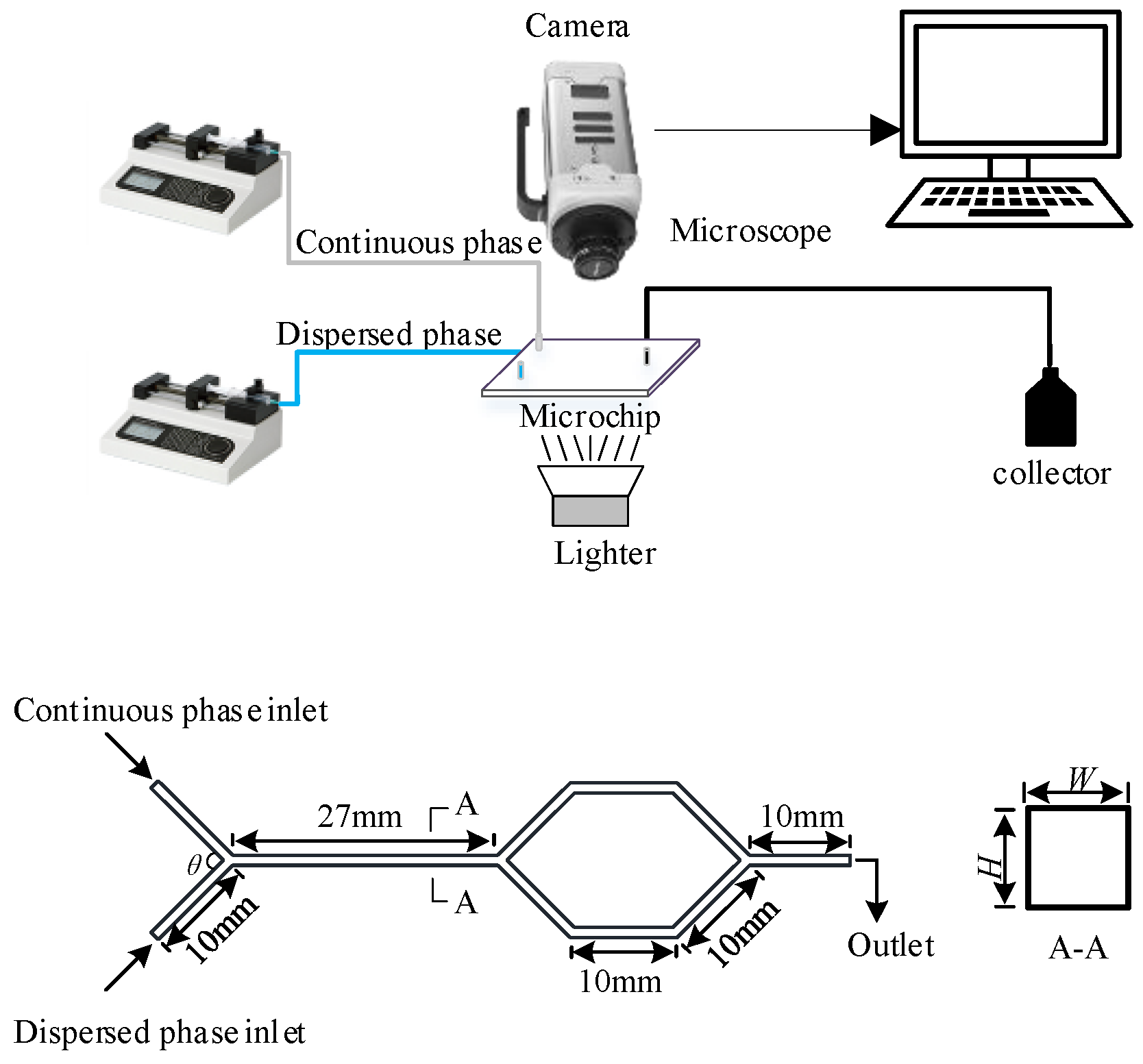
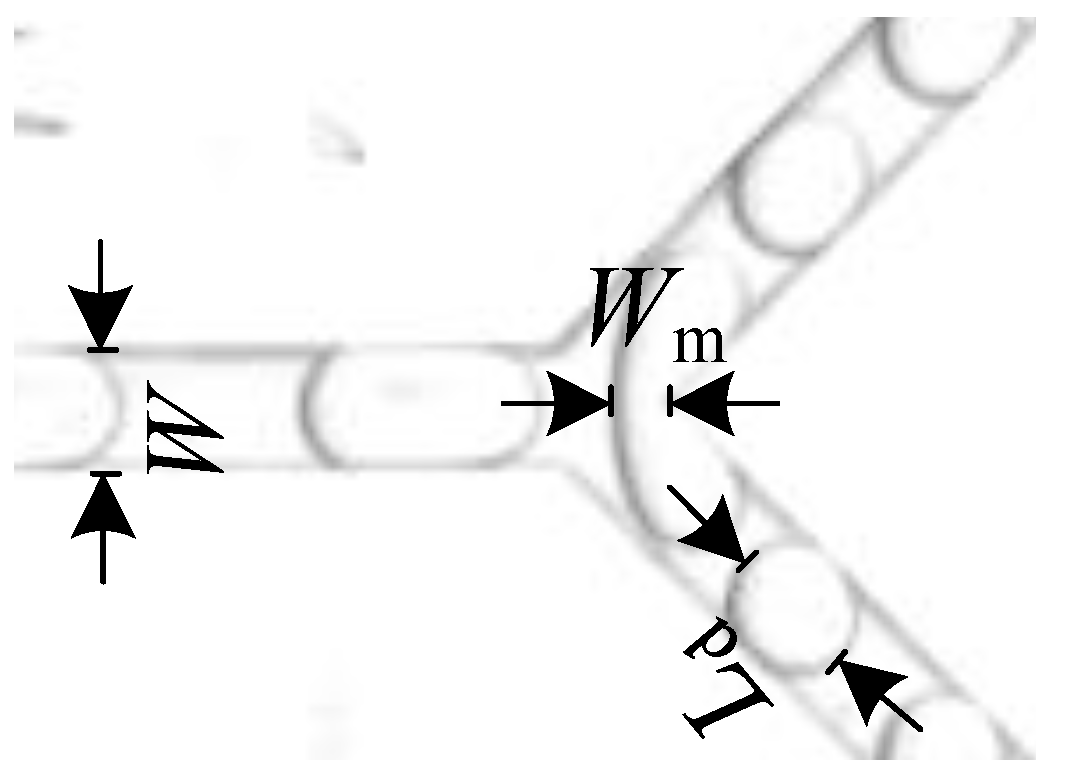

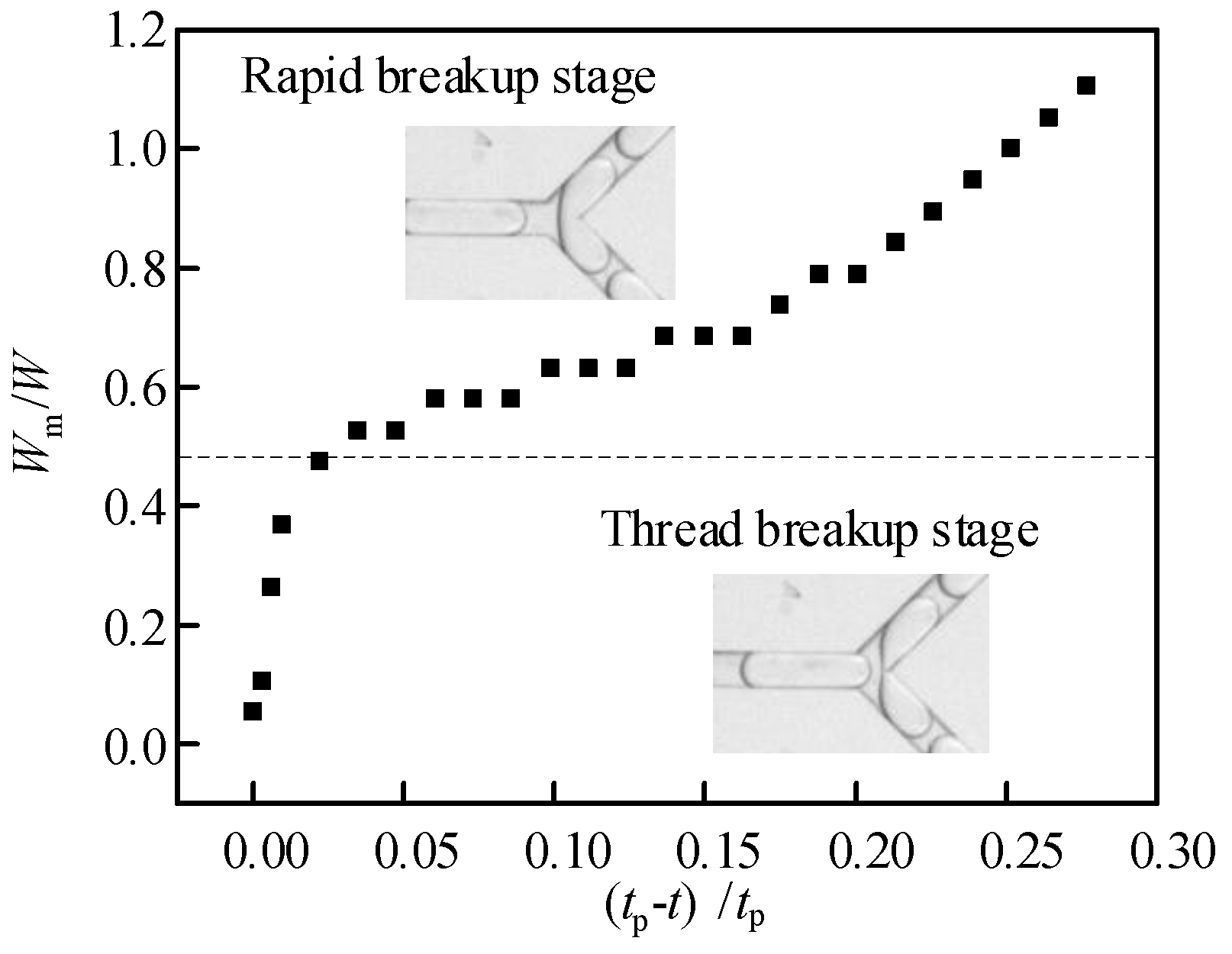

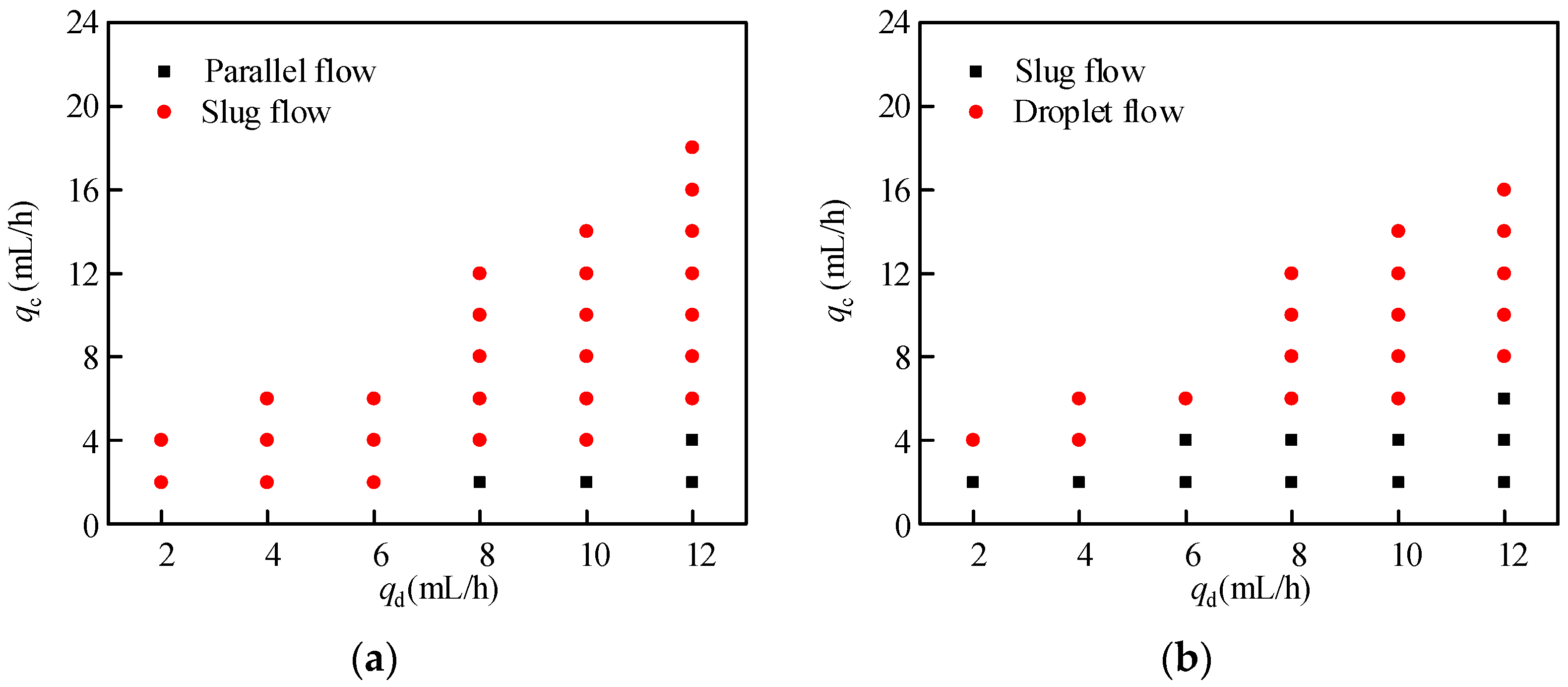
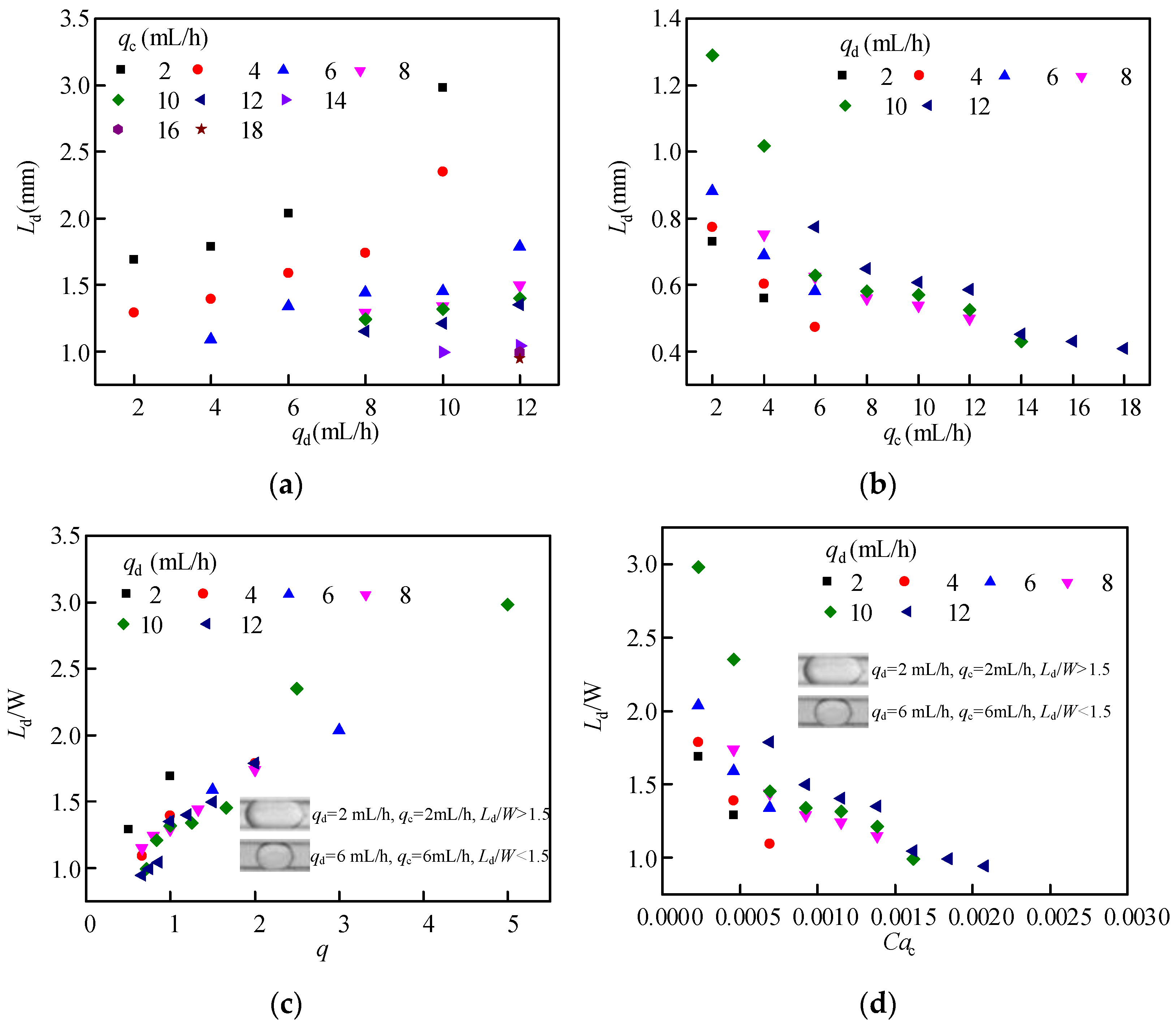

| Fluid System | μ/(Pa·s) | ρ/(kg·m−3) | γ/(N·m−1) | |
|---|---|---|---|---|
| Continuous phase | 0.5 wt % SDS | 0.00135 | 971.53 | -- |
| Discrete phase | Silicone oil | 0.01 | 901.4 | 0.0118 |
Publisher’s Note: MDPI stays neutral with regard to jurisdictional claims in published maps and institutional affiliations. |
© 2022 by the authors. Licensee MDPI, Basel, Switzerland. This article is an open access article distributed under the terms and conditions of the Creative Commons Attribution (CC BY) license (https://creativecommons.org/licenses/by/4.0/).
Share and Cite
Lei, L.; Zhao, Y.; An, J.; Zhang, B.; Zhang, J. Breakup Dynamics of Droplets in Symmetric Y-Junction Microchannels. Appl. Sci. 2022, 12, 4011. https://doi.org/10.3390/app12084011
Lei L, Zhao Y, An J, Zhang B, Zhang J. Breakup Dynamics of Droplets in Symmetric Y-Junction Microchannels. Applied Sciences. 2022; 12(8):4011. https://doi.org/10.3390/app12084011
Chicago/Turabian StyleLei, Li, Yuting Zhao, Jun An, Bo Zhang, and Jingzhi Zhang. 2022. "Breakup Dynamics of Droplets in Symmetric Y-Junction Microchannels" Applied Sciences 12, no. 8: 4011. https://doi.org/10.3390/app12084011
APA StyleLei, L., Zhao, Y., An, J., Zhang, B., & Zhang, J. (2022). Breakup Dynamics of Droplets in Symmetric Y-Junction Microchannels. Applied Sciences, 12(8), 4011. https://doi.org/10.3390/app12084011







